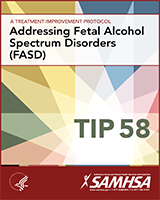How-To 2.6How to Assess the Frontline Staff and Clinical Supervisors for Change (, Step H)
The committee determines the specific program and staff members who will be the first to implement change.
Are there incentives/organizational supports for change (ATTC Change Book, p. 29)?
What are the barriers to change (ATTC Change Book, p. 28)?
At what stage of change is the program staff (ATTC Change Book, p. 29)?
How will staff practice be affected (ATTC Change Book, p. 29)?
What additional support will staff need (ATTC Change Book, p. 29)?
Does staff have the prerequisite knowledge, attitudes, and skills?
What training and continuing resources are necessary to provide the core intervention com ponents?
See also Sample Policies 1-6 and - in this chapter for additional information to be used in assessing staff readiness. See Appendix C, Public and Professional Resources on FASD, for links to training resources.
